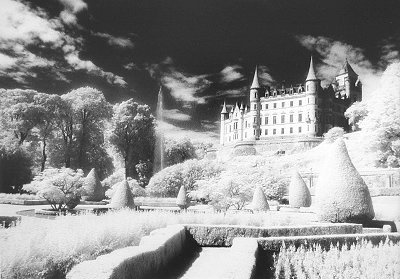Dunrobin Castle

Copyright 2000 Catriona Fraser
Limited Edition of 100



Ancestral home of Clan Sutherland, one of the most ancient Earldoms of Scotland. The Sutherlands may have been Pictish Thanes before being absorbed by the Scottish takeover of the Pictish kingdoms, which may have taken several centuries in these northern parts.
Many Pictish stones have been found in and around the castle grounds. First mentioned as a Sutherland stronghold in 1401, Dunrobin Castle was originally built in the late 13th century by Robert, 2nd Earl of Sutherland and the Sutherlands ruled these northern lands from here until their property passed by marriage to the Gordons in 1652. The lands again passed by marriage in the 18th century to the Trentham Marquis of Stafford.
The name "Dun Robin" in Gaelic means "Robin's hill" or "fort," may have come from Robert, the 6th Earl of Sutherland who died in 1427. The 13th century "keep" is no longer visible from the outside of the castle but can be seen from the corridor windows. This "keep", with walls six feet thick and a vaulted ceiling, stood isolated for some 200 years until a new staircase and a long high house were added. It was encased by a series of additions from the 16th century onwards. In 1785 a large extension was constructed.
In 1845, Dunrobin was extensively remodeled by the architect Sir Charles Barry, who had designed the Houses of Parliament. This renovation encased the early castle and gave the castle most of its current appearance with the conical spires. The massive baronial residence was inspired by Queen Victoria's new residence at Balmoral. Barry also laid out the gardens in the 1850s. After a fire in 1915, the Scottish architect Sir Robert Lorimer conducted repairs and altered the top of the main tower and clock tower at the north side of the building to the Scottish Renaissance style.
Septs of Clan Sutherland are: Cheyne, Clyne, Duffus, Federith, Gray, Keith, Mowat, Murray and Oliphant. There are additional families that are not actually septs, but come from Sutherlandshire or have been associated with Clan Sutherland. For example, Norman and O'May are associated with the Clan and recognized as such by the Standing Council of Scottish Chiefs.

